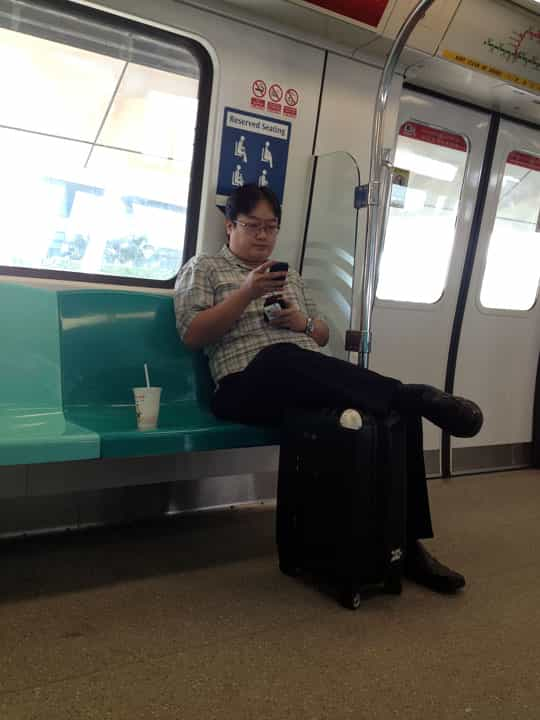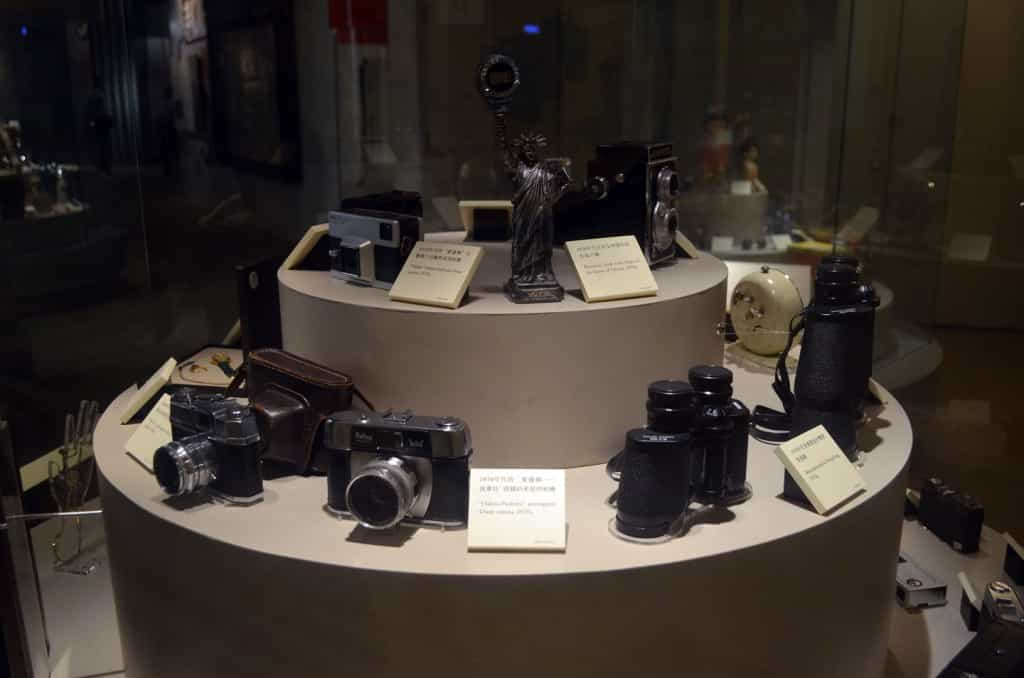The strange realities of airfare often have a big influence on where I go and when. In this case, I was looking forward to flying from Bali to Guangzhou, but realized that flying to Singapore and then to China was actually a lot cheaper. And I also realized it was cheaper to fly to Hong Kong and take a train from there. I needed no more reasons to re-visit these amazing cities.
So I went and had soup dumplings with my Singaporean friend Rachel, whom I had met in Indonesia. It was so good, I went back to the same place for lunch the next day, this time with my Czech expat friend Eva. In both cases, I was a bad tourist and failed to take the required selfies.
Going from chaotic East Timor to Singapore was quite a shock, but despite its reputation, Singapore can sometimes be a little wild.
Just look at this crazy anarchist, sitting in the reserved seats, drinking soda pop on the train, right under the sign warning that such behaviour can result in a S$500 fine (US$400)!
Having only a day to visit, I headed for Gardens by the Bay, a spectacular urban botanical garden of over 1 million square meters which I had never been too, but had been inspired to visit by the pictures my Australian friends Sarah and Jon had shared on Facebook. Apart from the outdoor gardens, the recently built complex (2012) includes two cooled conservatories: the Cloud Forest, on the right, and the Flower Dome, which was unfortunately closed for its one day of monthly maintenance.
The artificial mountain in the flower dome.
It includes walkways not designed for those with fear of heights.
The dome is beautiful, impressive and very photogenic. Perhaps even more so when they “water” the plants.
The place is visited from the 5th floor going down. In the basement, an environmentally oriented exhibit presents a video on climate change. While I often make fun of climate change alarmists, this piece of entertainment was the most ridiculous I had ever seen. A quote on what the world will be like in 2100: “A dry rock burning in space”! I was also amused by hearing the prediction that due to rising temperatures, temperate regions would begin facing the threat of malaria in 2050. Ironically, on the same week it was announced new antibodies that could block a signal pathway in the malarial parasite had been developed by a team at Singapore’s own Nanyang Technological University!
Of course, environmentalists are often smart people and they realize that the scientifically ignorant majority only pays attention to doomsday scenarios. But sometimes, whether or not they believe their own nonsense, the lack of confidence in human ingenuity they display is depressing. “Major world cities will be under water”! You mean like Amsterdam, under sea level for centuries and doing quite well. Miami residents will choose not to build dikes and instead sink in the ocean? Of course they will. The world will come to an end because hundreds of millions will move away from the coasts over the course of the entire century? Billions have moved from the countryside to cities in the technologically limited 20th century and as far as I can see, the world didn’t end, although I will grant condo prices in Toronto did skyrocket as a result.
Sorry for the rant, now look at the Supertrees! Between 25 and 50 meters in height, they provide shade, solar power, a structure for plants to grow on, etc. Very unique and impressive to walk around them and strangely reminiscent of the movie Avatar. Click on this link for a bad picture I took of them at night during my last visit to Singapore earlier this year. In my defence, it was raining.
The Supertree walkway.
Upon leaving Singapore, I stumbled upon this very impressive sculpture created by the group ART+COM. It is made of 1,216 copper coated droplets, each powered by its own computer controlled motor. They all move in unison to create very impressive effects. The Singapore authorities use it as a trap to detect drug users upon arrival in the country. Anyone who recently smoked marijuana or used LSD is completely incapable of walking away and after 2 hours spent watching it non-stop with eyes wide open, they get arrested. Before you consider buying one for your condo, keep in mind the whole thing weighs 26 tons.
So off I went to mesmerizing Hong Kong. One of the most photogenic cities for impressive urban landscapes, HK greeted me with 24 hours of rain. So instead of walking around, I headed indoors to museums. But perhaps I can show you some pictures I took during my first visit to the city, in 2004.
Hong Kong seen from the summit of Victoria Peak.
And the daily evening laser and light show seen from the opposite end, across Vicoria Harbour in the lively and busy Kowloon peninsula.
Most of the major museums are actually on the Kowloon side, and for the first time, I chose a hotel on that side of Victoria Harbour. This display of banal manufactured products at the Hong Kong Museum may seem totally uninteresting, but it took me back to the days of my youth. Before Deng Xiaoping transformed China into a capitalist country with a “Communist” macro-management system, all the cheap electronic gadgets came not from China, but from British Hong Kong (and even Japan). It made me wonder how different the economic world of tomorrow will be.
After all, this was Hong Kong only 42 years before I took my pictures.
Despite the fact that I uncharacteristically rambled about human progress in this post, I want to draw your attention to something which is surprisingly primitive yet incredibly efficient in super-modern Hong Kong: bamboo scaffolding tied together with nylon straps. I had seen a documentary about this on TV, but never noticed it in person.
Steel scaffolding is not universal. As you can see in this post, in Ethiopia they use wood. Why? Because they can’t afford steel and because when the death traps they build collapse, compensation to the family costs less than renting a steel scaffold.
But in Hong Kong, they do it because they think it’s better; and it is indeed very, very good. Of course, the structures are much weaker than a steel scaffold, but what constitutes 99% of what a steel scaffold must support? Its own weight. These bamboo things weigh nothing. The workers tying them together require years of training before getting certified and I would feel ten times more confident climbing in one of them than a lot of concrete structures I have seen around the world.
Finally, upon going through internal customs between HK and mainland China I was surprised by an unusual sign. While most countries restrict the importation of weapons, currencies, dangerous goods or alcohol, here they restrict the amount of baby formula you can carry to two cans per person. Apparently after the 2008 adulterated baby formula scandal, which affected hundreds of thousands of babies, hospitalizing tens of thousands and killing 6, the country, as one would expect, lost confidence in local suppliers and foreign formula became in extremely high demand. People were apparently trying to board the passenger train almost with crates of it, thus leading to this restriction. I regretted not buying 2 cans of my own, I could have a few yuan in profit on the other side!
#China #Singapore



































